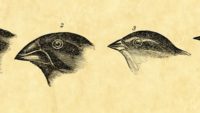Scientists have found genetic evidence suggesting that legume trees emerged from separate African tree populations during the Ice Age.1 This conclusion is consistent with the creation model of a post-Flood Ice Age. Lead researcher Dr. Rosalía Piñeiro of the University of Exeter was quoted as saying, We examined the DNA of five legume trees, which are found widely in Africa… More… …read more Source: icr.org
Their formation is a ‘chicken and egg’ problem for evolution. …read more Source: creation.com
Contrary to media hype, anole lizards on the Bahamas are not evolving …read more Source: creation.com
Animal migrations occur all over the earth among many types of creatures, with some winged creatures (birds and insects) making the most extreme and lengthy ones. Among insects, the globe skimmer dragonfly (Pantala flavescens) is exceptional—being able to fly up to 3,730 miles across the open ocean. Scientists are finally beginning to unravel the required specificity behind the anatomical, behavioral, and metabolic complexity that … More… …read more Source: icr.org
Viking ‘Dragons of the Sea’ defy evolutionary theory …read more Source: creation.com
Are cratered planetary landscapes and moonscapes, and colliding galaxies, evidence against an Intelligent Designer? …read more Source: creation.com
By Frost Smith Just three weeks after fertilization, the tiny unborn baby’s brain, spinal cord, and other organs begin to form, demonstrating early complex development. …read more Source: AIG Daily
What are the odds that a buried animal would still have intact DNA after 125 million years? Researchers publishing in the journal Communications Biology said exactly that.1 But it’s what they elected not to say that tells just as big a story. The cartilage-containing fossil named Caudipteryx came from China’s famous Jehol Biota. Although the study authors along with most scientists lab… More… …read more Source: icr.org
How easy it seems to simply adjust an age that does not fit the evolutionary long-age narrative. Sometimes, there are no qualms about changing a ‘date’ by a billion years! …read more Source: creation.com
It’s the hardest substance in the human body. But be warned: If you’re slack with your dental hygiene, fixing your tooth enamel ain’t easy. …read more Source: creation.com
By Ken Ham Australopithecus sediba—did it walk like a human but climb like an ape? According to a recent study, new lower back fossils of this so-called “human ancestor” supposedly “settles a decades old debate proving early hominins used their upper limbs to climb like apes and their lower limbs to walk like humans.” Now, we’ve said for years that A. sediba was just an ape. But does this new study show it was indeed a “missing link,” as the article claims? Paleontologist Dr. Gabriela Haynes, one of the members of our research team, shares this about A. sebiba and [More]
The Coconino Sandstone, famously exposed near the top of Grand Canyon’s splendid sedimentary layers, remains a controversial rock. Two counterclaims vie for its origin. If wind formed the Coconino’s now-hardened sand dunes, then the whole region must have been dry land exposed to the air—unlike the Bible’s portrayal of a worldwide Flood. But if water formed the Coconino’s features, then the whole region must have lai… More… …read more Source: icr.org
Scientists are still trying to out-do each another by finding the biggest dinosaur. Brian Curtice, from the Arizona Museum of Natural History, recently threw his name in the hat with a new analysis of the long-necked dinosaur Supersaurus.1 His findings were presented virtually at the Society of Vertebrate Paleontology’s Annual meeting. Supersaurus was originall… More… …read more Source: icr.org
‘Evolution in action’ turns out to be nothing of the sort. ‘Bacteria evolve resistance to antibiotics’, ‘Insects evolve resistance to pesticides’, ‘Organisms evolve tolerance to pollutants’—these headlines lead many to think that the molecules-to-man evolutionary process is happening before our very eyes. …read more Source: creation.com
A question is asked about sceptics’ responses to creationists using speedy growth rates of speleothems under man-made structures to illustrate speedy natural cave formations …read more Source: creation.com
By Dr. David Menton Look at those luscious pancakes! Can’t you just taste them? You can—because of God’s intricate design for your senses. …read more Source: AIG Daily
By Harry F. Sanders, III How we know human life begins at conception, as the Bible affirms, and the cultural consequences of ignoring the facts …read more Source: AIG Daily
How could the earth get out of a global glaciation? …read more Source: creation.com
After the Flood, numerous animals adapted to special environments. Let’s look at how some special animals, the sandcat, fennec fox and mulgara adapted to the desert heat! …read more Source: creation.com
By Harry F. Sanders, III How mutations could be removed from a genome through inbreeding, though the original integrity could not be restored in reality or in an evolutionary paradigm. …read more Source: AIG Daily
Fossil experts are delighted, but somewhat bemused, by the discovery of a beautifully preserved snake, complete with four tiny, but definitely functional, legs-opinion is divided! …read more Source: creation.com
By Ken Ham Evolution—will it happen in basically the same way, no matter where in the universe it occurs? An article from New Scientist argues yes, saying it doesn’t matter what “operating system” (e.g., DNA) that life uses: it will evolve via natural selection regardless. But what assumptions are going into such an assertion? Well, the article describes evolution, which it calls “a fact of life,” in this way: Here on Earth, organisms that just so happen to be better adapted, or “fit”, for their environment, perhaps by virtue of a fortuitous mutation, tend to survive longer and leave more [More]
One of the many mysteries of biology is how a creature like a web-weaving spider with a tiny brain is able to systematically construct an elaborate web with amazing elegance, complexity, and exacting geometric precision. And to make the spidery task even more amazing, the creature does it blindly only using the sense of touch—an exceedingly complex mechanosensory-based application. A newly released study shows that this remarkable skill is … More… …read more Source: icr.org
By Dr. Danny R. Faulkner The big bang has been the dominant cosmogony for more than a half century, but the lithium measurements in the universe do not match the model. …read more Source: AIG Daily
Recent Icelandic volcanoes highlight major changes to landform in a matter of months and years. …read more Source: creation.com
It is hard to identify the behavior of creatures just from their fossils. An international team of paleontologists tried just that on a big group of dinosaur fossils from Argentina. Their Mussaurus specimens included developmental stages from egg through juveniles to adults. Clues from the 100 eggs and 80 specimens suggested to this team that these dinosaurs had social behaviors. A look at the traits behind these behaviors reveals a crea… More… …read more Source: icr.org
Natural selection can only select for the attributes an organism needs to survive, so how is it that creatures are endowed with a whole lot more than necessary? …read more Source: creation.com











































